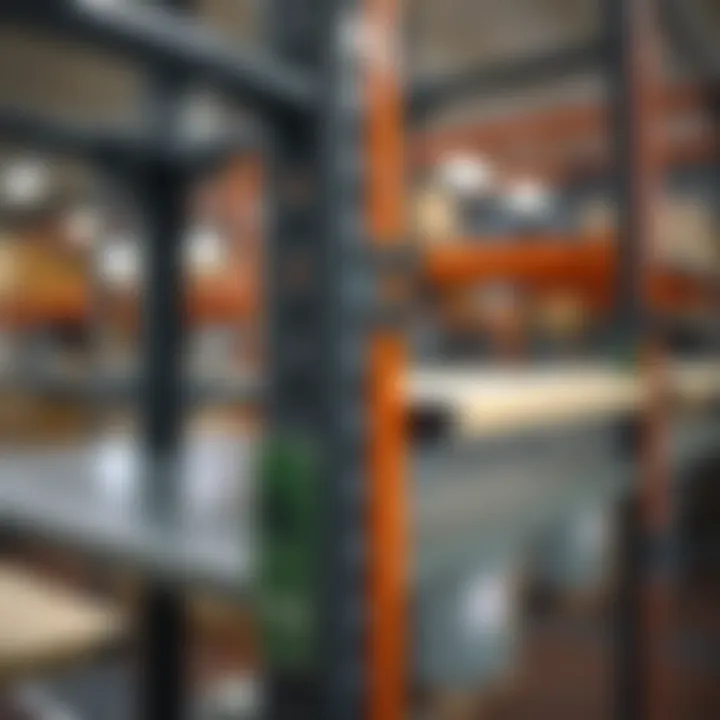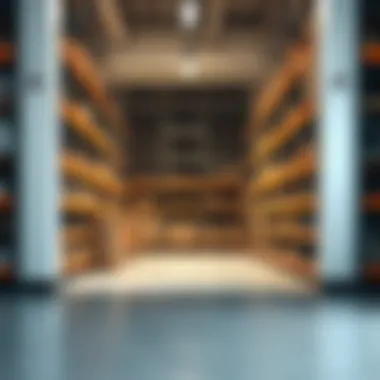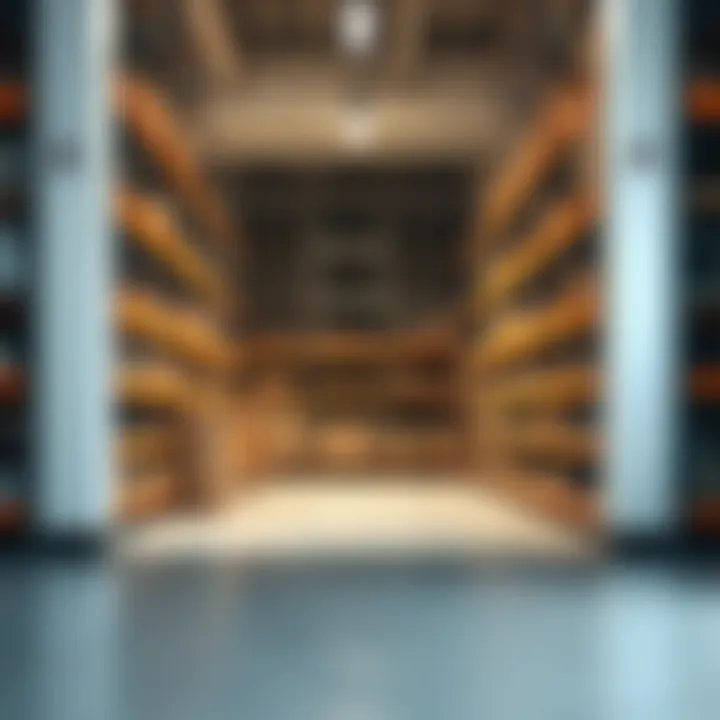Designing Effective Rack Systems for Every Space


Intro
In today’s world where every inch of space counts, the importance of effective rack systems goes beyond mere storage. The right rack can harmonize functionality and aesthetics, creating environments that are not only efficient but also visually appealing. This article explores the nuanced process of designing a blueprint for effective rack systems. We will delve into various elements that influence both usability and looks. From understanding layout to selecting the right materials, every detail matters.
Whether you are a homeowner looking to declutter, a designer aiming to enhance a space, or a DIY enthusiast eager to tackle your next project, this guide will walk you through all the critical phases in crafting ideal rack systems.
Furniture Design Styles
Overview of Popular Styles
The world of furniture design is as diverse as it is fascinating. When it comes to selecting racks, understanding various styles can put you a step ahead in creating a cohesive look. From minimalist designs emphasizing sleek lines to rustic wooden racks that evoke warmth, it's important to recognize the styles that resonate with your space.
- Modern: Characterized by simplicity and function, modern racks often make use of metal and glass, ensuring a clean and sharp appearance.
- Industrial: Popular in urban settings, these racks utilize raw materials like metal and reclaimed wood, lending a rugged vibe to any environment.
- Scandinavian: Known for its lightweight aesthetics and functionality, this style favors pale woods and simple forms that bring brightness and airiness.
- Traditional: Featuring rich woods and intricate designs, traditional racks exude a sense of timeless elegance and sophistication.
How to Mix and Match Styles
Combining styles can breathe new life into any room. However, it requires a deft touch to create a harmonious blend rather than a chaotic clash. Here are some strategies to consider:
- Start with a dominant style. This will anchor your space and allow other elements to complement it.
- Use complementary colors that exist within your styles. For instance, pairing warm wood tones from traditional design with sleek metal from modern can yield a delightful contrast.
- Incorporate uniformity in materials. If your centerpiece is an antique wooden rack, consider modern elements in similar hues rather than stark contrasts.
- Balance the visual weight. In a heavily adorned traditional space, a few minimalist pieces can act as visual breathing spaces.
Practical Tips for Homeowners
Essential Buying Tips
When it comes to purchasing rack systems, knowing what to look for can save time and money. Here are some tips that will steer you in the right direction:
- Assess the space: Measure your area before diving into purchases. This prevents unwelcome surprises.
- Consider load capacity. Make sure the rack can support the weight of your planned items without sagging or compromising safety.
- Pay attention to finish: A good finish protects against scratches and moisture, especially in kitchens or utility areas.
- Think about accessibility. Ensure the design allows for easy reach to all stored items without requiring acrobatics.
Maintenance and Care Guidelines
Once your rack is in place, take care of it to ensure it remains both functional and stylish:
- Regularly dust and clean your racks to avoid build-up of grime.
- For wooden racks, apply appropriate furniture polish to maintain shine and protect against wear.
- Be mindful of weight distribution; heavy items should be placed lower to avoid tipping risks.
As we navigate the intricacies of designing effective rack systems, remember that every decision impacts the overall functionality and aesthetics of your space. Mastering these aspects will help you create a setup that is both practical and visually pleasing, enhancing the look of residential or commercial environments alike.
Prologue to Rack Systems
Rack systems serve as a foundation for a multitude of organizational needs, from storing books in a cozy reading nook to housing industrial equipment in vast warehouses. Understanding the various types and uses of rack systems is paramount for anyone looking to optimize their space, as the wrong choice can lead to wasted square footage and even safety hazards. The complexities of effective rack design stretch far beyond mere aesthetics; they marry functionality with the unique needs of a space, shaping how both residential and commercial environments can be navigated and experienced. This article aims to unpack the intricacies of these systems, providing insights that help both seasoned professionals and DIYers make informed decisions.
Defining Rack Systems
Rack systems can be seen as a collection of shelving units or storage solutions designed to support, display, or store a wide range of items. At their core, they vary in size, material, and design, each tailored to fit specific functions.
Types of Rack Systems Include:
- Shelving Racks: Great for organizing books, files or kitchenware.
- Industrial Racks: Built to support heavy-duty items, ideal for warehouses.
- Display Racks: Aesthetically pleasing, often used in retail to showcase products.
Whether one is organizing a home office or setting up a retail store, defining the type of rack system needed is the first step towards a successful layout. Each system must align with the intended use and can often be customized to fit a unique design vision. The integration of racks into a space not only addresses physical storage needs but can also significantly enhance the overall spatial dynamics.
Importance of an Effective Blueprint
Creating an effective blueprint for a rack system is akin to drafting a roadmap before a trip; it provides direction and helps avoid detours. Without a well-thought-out plan, users risk facing issues like overcrowded spaces or inefficient layouts that hinder accessibility.
A robust blueprint should encompass:
- Space Analysis: Understanding dimensions and traffic patterns.
- Weight Considerations: Estimating load limits to ensure safety.
- User Interaction: Considering how individuals will interact with the racks.
The blueprint acts not only as a guide but also as a visual representation of the intended layout. By laying out a precise plan, users can ensure that every inch counts and that their rack systems will serve their intended purpose efficiently and gracefully.
To sum up, understanding what rack systems are and the necessity of an effective blueprint sets the stage for tackling the elaborate world of storage solutions. From optimizing space usage to enhancing aesthetic appeal, the following sections will delve deeper into crafting these vital systems.
Understanding Your Space Requirements
In embarking on the journey of crafting effective rack systems, the first step is to get a firm grasp on Understanding Your Space Requirements. This is not merely a matter of measurements; it’s about envisioning how the space can be optimized for best use while ensuring functionality and aesthetics marry well. Bad planning at this stage can lead to an avalanche of problems later on. A well-thought-out design stems from recognizing the dimensions of the area and how the rack systems will operate within that framework. Determining both the physical spaces available for the racks as well as their intended use will serve as the backbone of any successful design.
Analyzing Available Space
Analyzing available space hinges on the ability to assess and visualize how the rack systems fit within an existing layout. Measure length, width, and height with precision. Don’t just jot down numbers like a robot, revel in the process of understanding how those numbers translate into real-world application.
Consider the following points during your analysis:
- Room Dimensions: Understand how the height and width will play into your rack system. Will it be a floor-to-ceiling installation, or will it occupy a smaller footprint?
- Obstructions: Are there light switches, power outlets, or heating vents? These need to be addressed to avoid putting racks in awkward or inefficient positions.
- Viewing Angles: Make sure the racks do not block lines of sight or create clutter that draws attention away from the overall design aesthetic.
Additionally, questioning the layout of the room can lead to creative solutions. For instance, a narrow hallway may benefit from vertical racking, maximizing the use of vertical space without intruding into walkways. This may remind someone of a game of Tetris, fitting the pieces together in a clever way.
Determining Functionality Needs
Next, we delve into determining functionality needs, which always holds the key to whether a design choice is effective or not. It's not just about how pretty the rack looks, but how well it serves your purpose.


Think about the following factors:
- Items to be Stored: Consider what will actually live on the racks. Books require different handling than kitchenware. An understanding of the range of sizes and weights you’ll store helps dictate the design and material used.
- Frequency of Use: Will these items be accessed often or only occasionally? This influences the height and placement of racks. Regularly used items might need to be placed lower for convenience.
- User Experience: Think from the perspective of someone who will interact with the rack. If it’s for kids, anything higher than their heads is a no-go. For an office, items need to be organized to promote flow and efficiency.
Incorporate these insights to develop a blueprint that reflects your needs while also fitting snugly into your available space.
"A well-structured plan not only meets the spatial requirements but also elevates the user experience in ways that remain unseen but are deeply felt."
By meticulously analyzing the space and clearly determining which functions your racks need to fulfill, you set the stage for a design that harmoniously blends utility with style, paving the way for an efficient and aesthetically pleasing environment.
Design Principles for Rack Systems
The design principles of rack systems play a crucial role in ensuring that a structure is not only visually appealing but also functional and durable. From understanding proportions to ensuring easy access, these principles help in crafting solutions tailored to specific needs. A well-thought-out design can help maximize storage while maintaining a clean and organized display. Below, we explore several key design principles including proportionality, balance, and flow.
Proportional Design Elements
Proportionality in design refers to the harmonious relationship between the size of an object and its surroundings. When it comes to rack systems, it's vital to consider how the dimensions of the racks relate to the space they will occupy.
- Scale: A rack that is too big may overwhelm a small room, while one that is too small may get lost or seem ineffective. Finding the right scale minimizes clutter while maximizing visibility and accessibility.
- Height vs. Width: There’s a fine line between a towering rack that draws the eye and one that feels cumbersome. For example, in a living room, a slimmer, taller rack may work wonders against a narrow wall, whereas a wider, lower option might fit snugly in a corner.
Finding the right proportions ensures that the rack is a complement to the area rather than an obtrusive presence.
Balance and Symmetry
Balance in rack design allows for visual stability. This principle can be achieved through both physical weight distribution as well as visual cues.
- Asymmetrical Balance: While many think of balance in terms of symmetry, asymmetric designs can create an intriguing look that feels dynamic and modern. For instance, a rack featuring varying sizes of shelves or compartments can break monotony and create unique visual interest.
- Color and Material: The mix of dark and light finishes can also imply balance within a rack system. A dark wood bottom shelf could be paired with lighter colored containers above, creating a harmonious blend.
It's essential to think about the layout of items within the rack as well. Arrange heavier items on the bottom to provide a solid foundation and avoid tipping hazards. This simple approach ensures effectiveness while maintaining an aesthetically pleasing look.
Flow and Accessibility
Accessibility is another critical element that should not be overlooked in the design of rack systems. Users should be able to reach and utilize the stored items with ease.
- Positioning: Place commonly used items at eye level or within easy reach. Items that are less frequently accessed can be stored higher up or further back. The flow should allow for smooth transitions and unobstructed visibility.
- Open vs. Closed Shelving: Open shelving is great for display and easy access, allowing you to see everything at once. Closed shelving, however, can offer neatness and dust protection for less attractive items. The design choice here depends on personal preference and function.
Materials Selection
Choosing the right materials is a cornerstone in crafting effective rack systems. It's a decision that resonates through the entire design process, impacting functionality, aesthetics, and even durability. Different materials not only define the look and feel of the rack but also dictate how well it performs its intended task. A well-thought-out selection of materials can lead to a harmonious balance between form and function, ensuring that the rack system not only complements the surroundings but also meets practical needs.
When we talk about materials, it’s not just about picking what feels nice or looks good. Here are some key factors to consider:
- Weight Capacity: Different materials offer varying levels of strength and support. Choosing the right one can prevent mishaps or damage to your goods.
- Durability: Will the material withstand daily wear and tear? Some are prone to rust or warping, while others are built to last.
- Aesthetics: The look of the rack can either enhance or detract from the interior design of a space. Choosing materials like wood or metal can significantly change the vibe.
- Cost and Availability: Some materials can burn a hole in your pocket, while others may be easier to source.
- Environmental Impact: As sustainability gains traction, the choice of materials must also consider ecological footprints.
"A good material is like a good foundation; it can hold everything together and withstand the tests of time."
By weighing these elements carefully, designers, homeowners, and DIY enthusiasts can create rack systems that truly fit their needs. Let’s delve into the three prominent categories of materials: wood, metal, and composite materials.
Wood: Traditional Elegance
Wood has long been a favorite in furniture design, exuding warmth and a sense of home. Its natural texture and beauty make it a go-to choice for many. When utilizing wood in rack systems, several factors come into play:
- Aesthetic Appeal: The richness of various woods like oak, walnut, or cherry can instantly uplift a room. They can easily be finished or stained to match existing decor.
- Customizability: Wood can be easily cut, shaped, and assembled, which allows for tailored solutions that suit specific accentuating styles.
- Sustainability: Sourced responsibly, wooden materials can be a sustainable choice, especially from certified renewably managed forests.
However, one must be cautious of wood's shortcomings. It can be susceptible to moisture and warping, so proper treatment or placement is crucial. Lightweight yet robust options might also be worth exploring, depending on the intended load.
Metal: Industrial Strength
Metal racks bring a bold, industrial edge to any setting while offering unmatched strength and durability. Steel and aluminum, in particular, offer the ability to bear heavier loads, making them suitable for both residential and commercial applications. Here’s why metal might be the choice to consider:
- Sturdiness: Metal racks can hold a significant amount of weight without bending or breaking, which is vital for long-term usage.
- Maintenance-Free: Unlike wood, metal doesn’t require as much upkeep. A simple wipe down often does the trick, keeping your rack looking new.
- Variety of Finishes: Metal can come with various coatings and finishes to resist rust and enhance visual appeal, enabling it to fit into diverse styles.
While metal boasts a lot of benefits, it’s essential to pay attention to the potential for sharp edges and temperature variations, which can impact usability.
Composite Materials: Versatile Choices
Composite materials bridge the gap between versatility and performance, often incorporating a mix of materials to create a desirable product. They can take on characteristics from various elements, melding strength with aesthetic appeal. Here’s what makes composites worth considering:
- Lightweight Options: Many composites offer a lighter alternative to solid wood or metal, making them easier to handle and install, particularly in DIY situations.
- Resistance to Environmental Factors: Composites can be designed to resist moisture, decay, and pests, making them particularly appealing for specific applications.
- Cost-Effectiveness: Many composite materials can deliver a similar aesthetic to their more expensive counterparts at a fraction of the cost.
However, understanding the specific type of composite material and its limitations is essential to ensure it performs adequately for its intended use.
In summary, materials selection isn't just a process of choice; it's a fusion of creativity, practicality, and foresight. Each category of material brings valuable attributes to the table, making it essential to understand these features to craft effective rack systems that fulfill both aesthetic and functional purposes.
Innovative Storage Solutions
In the ever-evolving world of design, effective Innovative Storage Solutions emerge as a critical consideration, especially when it comes to rack systems. These solutions aren’t just about holding items; they represent the intersection of functionality, creativity, and efficiency in space utilization. As urban dwellings shrink and the demand for organized spaces rises, rethinking traditional storage methods becomes imperative. By adopting innovative approaches, designers and homeowners can turn cluttered areas into showcases of efficiency and style.
Modular Rack Systems


Modular rack systems offer flexibility and adaptability that are hard to come by with traditional fixed storage. Imagine a setup that can grow with your needs; that’s the beauty of modularity. These systems often consist of components that can be rearranged or expanded as necessary, making them perfect for spaces that experience varying demand.
- Benefits of Modular Rack Systems:
- Versatility: Easily adjust the layout according to changing needs.
- Scalability: As your inventory or belongings grow, so too can your storage space without needing a complete overhaul.
- Enhanced Aesthetics: Modular units can be designed to complement any style, from rustic to modern.
For comparison, a static rack requires a considerable commitment to a design that may become impractical as requirements evolve. Embracing modularity can lead not only to efficiency but also to a pleasing aesthetic that resonates with personal style and functional purpose.
Custom-Built Racks
Turning to custom-built racks introduces a bespoke element to storage solutions. Often, pre-fabricated systems might not fit the specific niches of a space, or they may fail to accommodate unique items that need specialized handling or display. Custom racks are designed specifically for those needs.
When considering custom solutions:
- Think about the materials that work best for the intended use.
- Account for the specific dimensions required - every inch counts in tight spaces.
- Factor in future needs; will there be an anticipated change in what your rack holds?
A direct benefit of custom solutions is that they not only fulfill practical roles but also enhance the overall design language of a space. Think about the stunning visual impact a well-crafted custom rack can have in a living room versus a basic, boxy solution.
Multi-Functional Furniture Incorporating Racks
The trend of multi-functional furniture incorporating racks reflects a shift toward maximizing utility while minimizing footprint. This concept is especially beneficial in smaller spaces where every square foot holds potential for creativity.
- Key Features:
- Dual Purpose: Think about a coffee table with shelving underneath. Functional yet stylish.
- Space Savers: Armoires that serve as a rack while housing various compartments for other uses.
- Integration: Items that blend seamlessly into the décor while maintaining their practicality.
This approach allows for a blend of storage and design, turning racks from mere organizational tools into stylish, statement-making pieces. Not only are you addressing storage needs, but you're showcasing a creative design philosophy that prioritizes both function and form.
"The key to innovative storage lies not only in the utility it provides but also in the aesthetics it brings to a space."
Embracing these innovative storage solutions can significantly elevate the functionality of both residential and commercial environments. When considering rack systems, think outside the box and be open to adaptations that cater to ever-changing needs.
Practical Considerations
When designing effective rack systems, it's paramount to consider practical elements that can impact both functionality and aesthetics. These considerations range from understanding how much weight a rack can handle, to the upkeep required to maintain its structure and appearance. Designers, retailers, and homeowners all need to take a deep dive into these practicalities to ensure a seamless integration of racks that not only look good but stand the test of time.
Weight Capacity and Load Distribution
The first thing on the agenda when crafting rack systems is weight capacity. This is not just about knowing the maximum load a rack can bear; it's about understanding how to distribute that weight effectively. Placing heavier items at the bottom and gradually lighter ones on top is a strategy that can help maintain balance and prevent tipping. For example, if you're designing a rack for kitchen use, heavier pots and pans should sit lower, while lighter items like herbs or spices can find their place on higher shelves. This methodology promotes stability and longevity of the rack.
When considering weight capacity, take note of the materials used in construction. Metal racks typically have higher load capacities compared to wood or composites, making them ideal for heavy items. Here are some key points to keep in mind:
- Material Strength: Know your materials—steel can often bear more weight than aluminum, for instance.
- Rack Design: Understand the design; racks that are designed to hold weight evenly will perform better than those that do not.
- Testing: If you're unsure, running weight tests during the design phase will save you headaches later.
"A well-structured rack system not only enhances the aesthetic appeal of a space but also ensures safety and efficiency."
Maintenance and Durability
A rack is only as good as its longevity—this brings us to maintenance and durability. The choice of materials plays a significant role in how much upkeep you'll need.
Wooden racks can offer a warm aesthetic but might require regular sealing and polishing to protect against moisture and wear and tear. On the other hand, metal racks, while generally more durable, may need periodic rust prevention treatments, especially in humid environments like kitchens.
Here are a few practical tips to enhance the durability of your rack systems:
- Routine Inspections: Schedule regular checks for any signs of wear, especially in high-use areas.
- Cleanliness: Keeping racks clean will help maintain their appearance and durability. Dust, grime, and spills can cause early degradation.
- Weight Management: As mentioned before, be mindful of how much weight you're placing and ensuring that it is not exceeding the recommended limits.
Integrating Racks into Home Design
Integrating racks into home design is not merely about practicality; it’s about creating synergy between aesthetics and functionality. The right rack systems can enhance the visual appeal of your space while serving a vital purpose in organization and storage. When carefully considered, racks can act as both striking focal points and discreet storage solutions, making them an essential component of any home design. In today’s fast-paced world, where square footage often comes at a premium, harnessing the power of rack systems helps optimize your personal space while maintaining an inviting atmosphere.
One of the prime benefits of incorporating racks into home design lies in their versatility. They can cater to a range of needs, from showcasing books and art in the living room to providing essential storage in the kitchen. Furthermore, utilizing racks facilitates more efficient use of limited floor space, transforming areas that might otherwise feel cramped or cluttered into functional showcases of both style and order.
Before diving into specifics, consider the different aspects that come into play when integrating racks into home design:
- Design Consistency: Ensure the rack design aligns seamlessly with the existing decor. Whether it’s a rustic wooden shelf in a cozy cottage or sleek metal frameworks in a contemporary apartment, the design should complement the overall style.
- Material Suitability: Selecting the right material is crucial, especially in determining durability and weight capacity. For example, a wooden rack may bring warmth into a space, while metal could enhance its modern charm.
- Positioning and Accessibility: Thoughtful placement significantly improves usability. For instance, high shelves should be reserved for items used infrequently, while daily essentials should be at arm’s reach.
Living Room Applications
In the living room, racks offer a myriad of possibilities for enhancing both storage and decor. A well-placed bookshelf can be adorned not just with books but also with decorative items that express personality and style. Consider the following applications:
- Bookshelves: Floor-to-ceiling bookshelves can create a library-like atmosphere, inviting relaxation and contemplation.
- Display Racks: Floating shelves provide an excellent opportunity for showcasing artwork or family photographs, allowing personal expression throughout the room.
A simple wooden rack coupled with warm lighting can transform a blank wall into a personalized gallery. This flexibility allows individuals to adapt their living environments to changing tastes over time.
Kitchen and Dining Areas
The kitchen is often the heart of a home, and integrating racks within this space can blend utility with style. Here’s how racks can elevate the kitchen experience:
- Open Shelving: Consider open racks to display dishes, spices, or cookbooks. This reduces clutter and gives the kitchen an airy feel while ensuring that the most-used items are readily accessible.
- Hanging Racks: For pots and pans, hanging racks can save valuable counter space while adding a bit of flair to your kitchen. They can also facilitate easy access to cooking tools, streamlining meal prep.


In dining areas, displaying elegant tableware or decorative bottles on racks can promote a warm and welcoming vibe.
Home Office Solutions
As more people transition to remote work, the home office has gained importance as a productive space. Incorporating racks in these environments can enhance both function and aesthetics. The functional storage offered can help keep work areas tidy, which in turn can boost efficiency:
- File Storage Racks: Racks designed specifically for files can help maintain organization without sacrificing style.
- Desk Shelves: Above-desk shelves can hold essential tools, creating an environment conducive to focus and creativity, all while enhancing vertical storage capacity.
Ultimately, racks in home offices facilitate a personalized workspace where inspiration and productivity go hand-in-hand.
In summary, integrating racks into home design helps strike a balance between form and function, creating tailored solutions for every area of the home. By considering design consistency, material suitability, and strategic placement, you can leverage racks to achieve a harmonious and inviting living environment.
Commercial Rack Systems
In the vast landscape of storage solutions, commercial rack systems play a pivotal role, particularly in a world where efficient space usage translates directly into profit and productivity. From retail stores to massive warehouses, understanding the nuances of these systems is crucial.
Effective commercial rack systems are more than just metal frames and wooden shelves; they are a carefully considered method of organizing space, maximizing utility, and showcasing products. Many retailers and businesses realize that a well-structured rack can not only enhance the visual appeal of products but also facilitate smoother logistics and accessibility.
Retail Environments
In retail environments, the racks are often considered the backbone of the store layout. They act as a silent salesperson, guiding customers through the aisles and presenting products in a systematic manner. Here are some key benefits and considerations for using rack systems in retail:
- Space Efficiency: A well-designed rack can hold more items in less square footage, allowing retailers to make the most of their space. Imagine a clothing store with vertical racks that not only saves room but also makes clothes easily visible.
- Brand Identity: Racks can be customized to reflect a brand’s image, such as sleek, modern designs for high-end boutiques or rustic wooden racks for artisanal shops, creating an immersive shopping experience.
- Flexibility: Retailers can adjust their display based on seasonal trends. Movable racks allow quick redesigns without major expense, keeping the store fresh and engaging for returning customers.
Given these benefits, many retailers are moving away from traditional shelving in favor of innovative rack solutions. This shift has led to a blend of function and aesthetic that attracts and retains consumers.
Warehouse and Storage Facilities
Warehouse and storage facilities also stand to gain immensely from properly designed commercial rack systems. Here, the stakes are higher, as inefficiencies can be costly and counterproductive.
Why investing in the right rack system matters in these contexts:
- Load Capacity: Heavy-duty racks are designed specifically for high-weights, such as pallets of goods and bulky equipment. Ensuring the right load distribution across racks prevents accidents and maintains safety.
- Inventory Management: Implementing rack systems tailored for easy identification and access of inventory types can streamline operations, reducing the time spent searching for products. The use of barcodes or QR codes on racks facilitates accurate tracking and management.
- Optimized Workflow: An effective layout allows for a natural flow of operations. From receiving goods to storage and final shipping, the movement is smoother if racks are situated for efficiency, significantly boosting productivity.
A warehouse with a thoughtfully designed rack system can drastically alter the handling of goods, minimize bottlenecks, and enhance overall operational efficiency.
The right rack system does not just organize space; it can optimize processes and improve customer satisfaction.
Trends in Rack Design
The field of rack design is evolving at a rapid pace, aligning itself with contemporary needs and preferences that go beyond mere utility. Today, designers and homeowners must be attuned to these transformations to create spaces that not only function well but also resonate aesthetically with users.
The trends in rack design are crucial as they reflect the shifting paradigms in both personal and commercial environments. One of the key elements influencing this evolution is the increased awareness of sustainability. As we confront environmental challenges, the choice of materials and production methods becomes paramount. Businesses and individuals alike are motivated to consider their ecological footprint, often resulting in a preference for sustainable options that do not sacrifice style for practicality.
Sustainability in Material Choices
Opting for sustainable materials in rack construction is not just a trend; it's becoming a necessity. Materials such as bamboo, reclaimed wood, and recycled metals exemplify how designers are making conscientious picks while still delivering on design sophistication. Bamboo is notably favored for its rapid growth, making it a highly renewable resource. This can easily align with a modern aesthetic while propelling sustainability to the foreground.
Another aspect that deserves attention is the concept of upcycling. This involves taking discarded materials and repurposing them into new fixtures. Not only does this minimize waste, but it also brings a unique character to spaces, resulting in truly one-of-a-kind racks.
- Benefits of sustainable material choices include:
- Reduced environmental impact.
- Enhanced durability and longevity.
- Unique aesthetic appeal.
However, it's not just about choosing greener options; designers must also consider the sourcing and production processes. Materials sourced locally limit transportation emissions and support community economies. Ultimately, the conscious selection of materials influences the overall appeal, functionality, and life expectancy of rack systems.
Smart Technology Integration
As technology continues to permeate every aspect of our lives, its integration into rack systems is an undeniable trend. The rise of smart homes necessitates that storage solutions adapt to meet the demands of technologically savvy users. From racks equipped with integrated lighting to those featuring app-controlled functionalities, the emphasis is on creating environments that are not only stylish but also adaptable.
Installing features like built-in charging stations and LED lighting are becoming commonplace as they enhance user experience. Imagine open shelves that illuminate as soon as you approach or racks that alert you when items are running low. These innovations are reshaping how we view storage systems — demanding that they serve double duty by being both functional and intuitive.
"The future of rack systems lies in the duality of form and function — transcending basic design into a realm of smart, interactive solutions."
Additionally, smart technology brings customization into the fray, allowing users to personalize their storage based on their unique lifestyles. From climate-control features that preserve items to intelligent organization systems that suggest optimal layouts or space usage, the integration of smart technology is ushering in a new arena of possibilities for rack design.
In summary, the trends in rack design resonate with a collective push towards sustainability and smart technology. These trends not only provide functional benefits but also create visually compelling spaces that mirror our modern values. As these elements gain traction, the realm of rack systems transforms into a canvas reflecting contemporary lifestyles and future needs.
Closure and Future Prospects
The discussion surrounding rack systems reveals vital insights that can significantly influence both personal and commercial environments. Understanding how to craft an effective blueprint is more than just arranging elements; it’s about integrating functionality with aesthetic appeal. Highlighting the importance of a well-thought-out design process, we observe some key elements integral to successful implementation.
Benefits of Effective Rack Systems
Rack systems not only serve practical purposes in organizing space, they can also transform the look of an area while promoting efficiency. An ideal blueprint addresses several core benefits:
- Optimized Space Utilization: A carefully designed rack system ensures every square foot is used efficiently, especially crucial in compact living areas or busy commercial setups.
- Customized Aesthetics: With options ranging from modern metallic frames to rustic wooden shelves, racks can complement or enhance the overall design of a room.
- Enhanced Accessibility: A thoughtful design guarantees that items are easy to reach. This not only reduces time spent searching for objects but also minimizes frustration in both home and work environments.
Furthermore, as the demands of space evolve, so does the need for adaptable solutions. Future prospects in rack systems reflect a shift towards sustainability and smart integration. Here’s what to consider moving forward:
- Sustainable Materials: The trend leans towards using eco-friendly materials that maintain durability while also considering the environmental impact. This includes bamboo, recycled metals, and low VOC finishes that keep health concerns in mind.
- Integration of Technology: Smart racks equipped with sensors and connectivity features offer users the ability to monitor inventory levels, temperatures, and even environmental controls—an exciting leap for commercial rack systems.
- Adjustable and Modular Designs: As our needs change, systems that can be altered easily will be essential. Incorporating modular designs allows one to reconfigure setups without the expense of complete replacements.
It's clear that the evolution of rack systems continues to adapt to the needs of users today and anticipates what’s needed tomorrow. By keeping abreast of these trends and developments, enthusiasts can better equip themselves to make informed decisions in their design choices.
"The best designs are those that evolve with the user, blending effortlessly into their lifestyle while enhancing their environment."
By staying informed on these elements, designers, retailers, decorators, and DIYers alike can thrive by creating spaces that are not only practical but also harmonious to the eye and resilient for years to come. The future of rack systems is bright, fueled by innovation and the ongoing quest for improvement.















